The Sporting South
Carving a Legacy
For a son of the Chesapeake, crafting duck decoys carries on a connection to a golden age of waterfowling—and a sacred family tradition
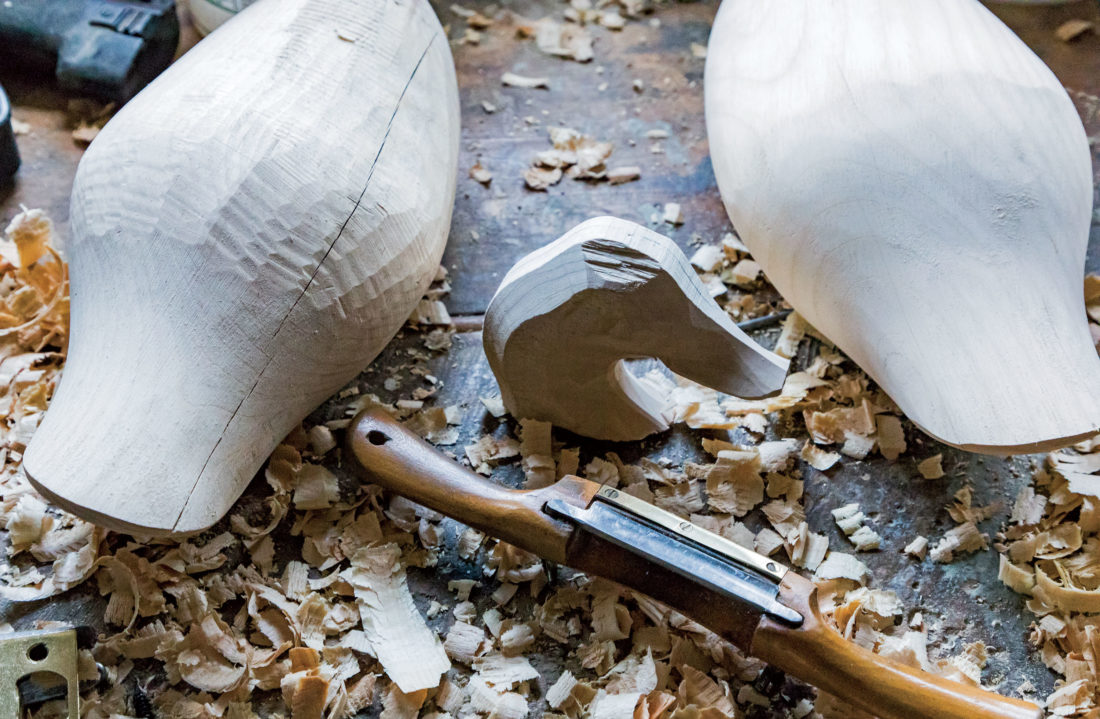
Photo: PETER FRANK EDWARDS
It was the boys’ job to load their father’s maroon Chevrolet pickup. The decoys were heavy, made of white pine from old barn beams or cedar from telephone poles, and keeled with lead. Each fit into its own paper bag, the tops crumpled shut. The three brothers, Bobby, Charles, and Joey Jobes, learned to carry up to ten at a time. “There was a tall camper cap on the truck,” Charles Jobes tells me, standing in his decoy shop in Havre de Grace, Maryland. He gestures above his head with a hunk of steaming-hot corned goose breast. “We could get a hundred geese and five hundred ducks in the truck, packed in tight.” From the northern Chesapeake, Captain Harry Jobes drove to decoy auctions, festivals, and shops from Easton, Maryland, to Kennebunkport, Maine, to North Carolina’s Outer Banks and to St. Charles, Illinois. He sold decoys for gunning rigs, for display, to collectors and the curious. He carved full-size decoys and miniatures, ducks as small as tiny ruddy ducks and birds as large as a tundra swan. Over some sixty-five years Jobes, while working a regular job piloting patrol boats for Maryland and the U.S. Army’s Aberdeen Proving Ground, sold tens of thousands of decoys.
Charles Jobes shakes his head at the memory. He is fifty-three, gray haired and wiry, with the energy of a two-year-old retriever. He and his brothers could not have known it, but as youngsters of seven, eight, maybe nine years old, they straddled two of the most important, and colorful, eras of American decoy carving. Harry Jobes learned to carve decoys at perhaps the most famous piece of waterfowling real estate in the country, R. Madison Mitchell’s decoy shop in Havre de Grace, and he was keenly and proudly aware of his role as a legacy keeper. But the boys weren’t quite as dialed in. “We never gave it a thought,” Charles says. “We were just doing what our old man told us to do.”
That has changed in their adult years. The Jobes brothers now serve as ambassadors of an authentic strain of decoy carvers with a direct lineage to the masters of the market gunning days. All three brothers still carve, having navigated a fickle market that has seen stupendous growth, outrageous prices, crashes and booms, and convulsive change. It seems fitting that you can still find decoy carving’s pure essence in Havre de Grace, not far from the driveway where the Jobes boys packed that old Chevy tight, and from which their father introduced a tactile and affordable piece of Chesapeake Bay culture to distant shores.
Charles, the middle boy, is now a successful, widely sought decoy carver. His donations of body-booting hunts—a Havre de Grace tradition, in which hunters in survival suits stand in frigid water to their shoulders, gunning ducks and geese over traditional handmade decoys—raise thousands of dollars for conservation. And he is one of the rare carvers who know that every time he puts a knife blade to a block of wood the end result will sell, if it’s not presold already.
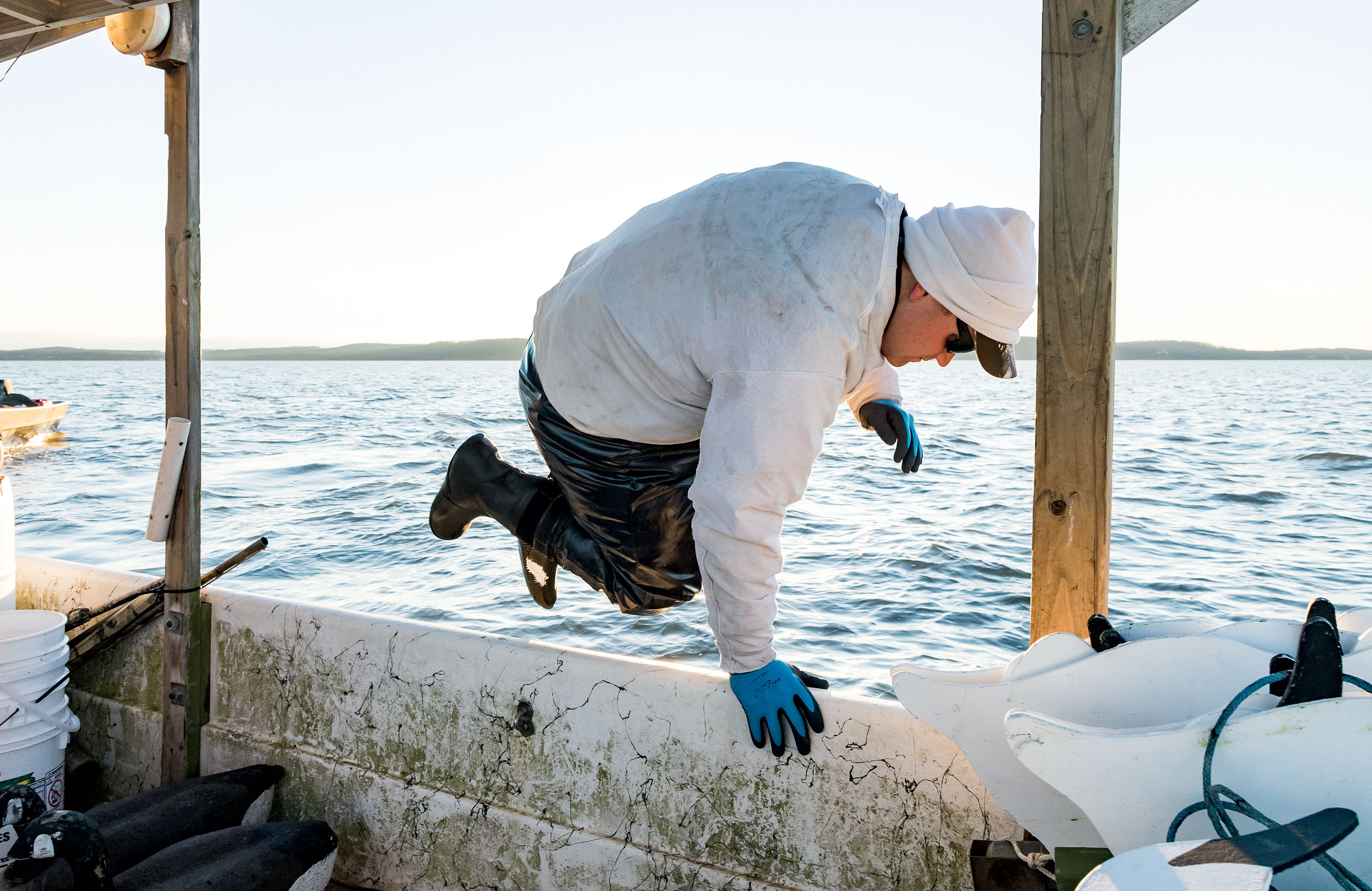
Photo: PETER FRANK EDWARDS
Hopping into the Chesapeake.
But all that belies earlier years of uncertainty, of the roller-coaster decoy market, of two kids and house payments and car insurance. It’s all forged a no-nonsense work ethic he finds difficult to set aside. He’d rather carve a decoy than ruminate too much about his place as a cultural emissary.
His wife, Patty, sticks her head in the shop door. “There’s more corned goose in the pot,” she says. “Eat all you want.”
“You bet, babe,” Charles answers. Memory lane will have to wait.
Havre de Grace hugs the northernmost west-ward shore of Chesapeake Bay, a working-class town where the Susquehanna River spills into the bay’s sprawling Rorschach test blot of brackish water with the sediments from a 27,510-square-mile watershed. Over the millennia, those silts and sands have settled to the bay’s bottom, creating a shallow-water delta—the Susquehanna Flats—where wild celery, redhead grass, and sago pondweed meadows sprawl by the acre. Ducks and geese pour into the region during the fall migrations, and for better than the last century, they’ve been met by waterfowl hunters who developed specialized techniques to pursue the birds in open shallow waters. The old market gunners, hunting to fill barrels with birds to ship to Baltimore and Philadelphia, employed sinkboxes that enabled a hunter to lie, literally, below the surface of the water. In the coldest weather, bushwhackers used a specialized boat, painted white and outfitted with a white canvas curtain at the bow, to look like floating ice. They’d set several hundred decoys on the flats, and scull into the birds with a long oar. After sinkboxes were outlawed in 1935, hunters developed the body-booting technique, a hunting tactic with seemingly masochistic overtones. Squirming into full-body survival suits, they stood in the tidal waters sans a blind, often up to their necks, hiding behind oversize goose and swan silhouettes outfitted with a small shelf to hold a shotgun.
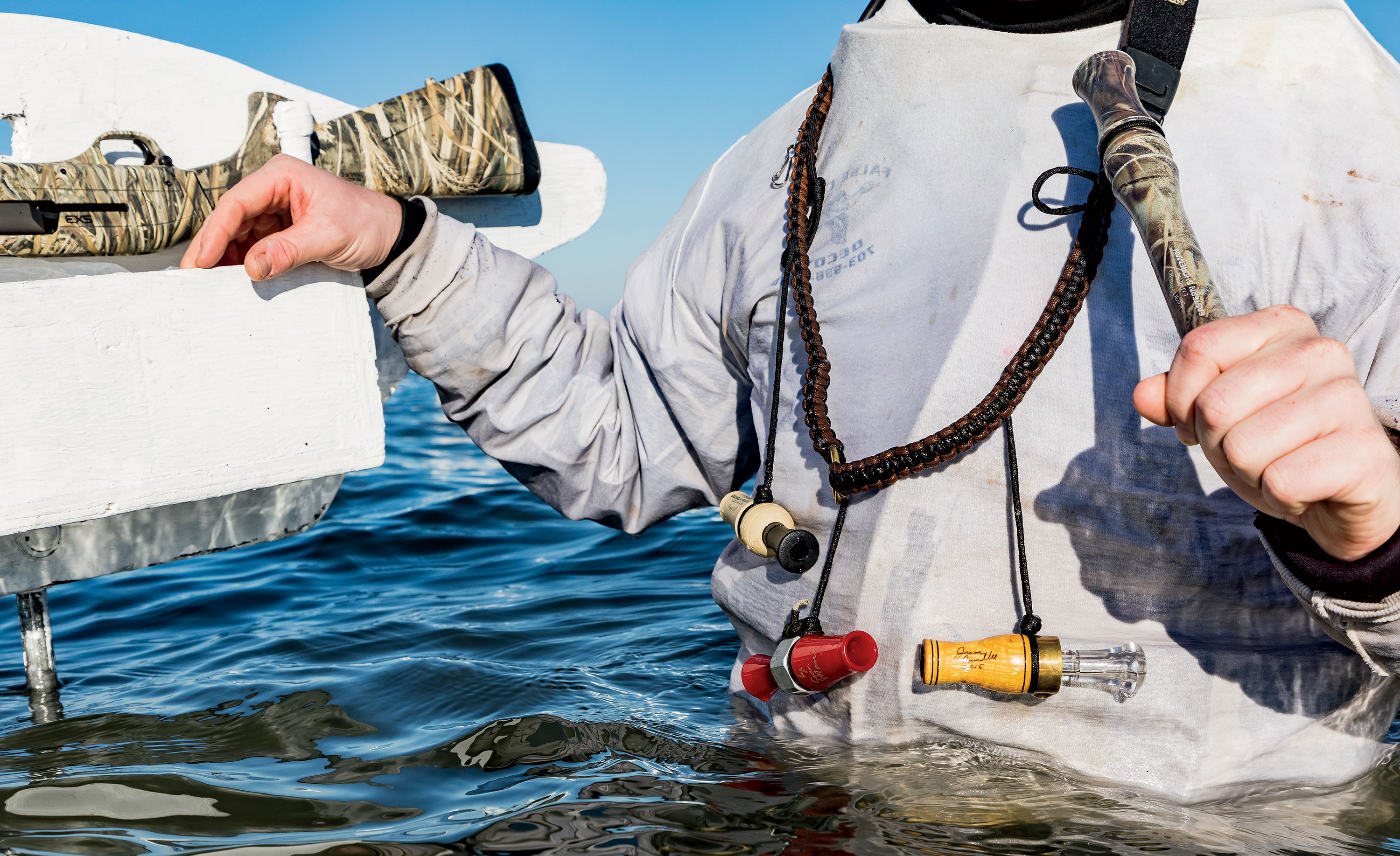
Photo: PETER FRANK EDWARDS
A hunter readies his goose call.
All those hunting methods required decoys, and a lot of them. In the 1920s and 1930s, as many as two dozen carvers operated in and near Havre de Grace, according to Kerri Kneisley, executive director of the impressive Havre de Grace Decoy Museum, and today, the small city of about 14,000 is the self-proclaimed Decoy Capital of the World.
Few of those carvers were as revered as the Jobeses’ close neighbor Madison Mitchell, who remains perhaps the most famous of the Chesapeake carvers. He was an accidental patriarch. An undertaker by trade, Mitchell was helping a cousin whittle decoy heads when the cousin died in 1926 with unfilled orders for fourteen hundred decoys. Mitchell recognized an opportunity. He built a shop behind his funeral home and installed a lathe and a belt sander. Orders flooded in. The shop soon evolved into a gathering place in Havre de Grace, where a small community of folks would carve or paint for Mitchell on weekends and after work.
Harry Jobes spent many hours at the Mitchell shop, and many a visit with his young sons in tow. Charles remembers there was always a handful of men sanding, puttying, and painting decoys, and carving heads. The young boy was infatuated with the entire process. “It was the coolest thing ever,” he recalls. “I knew that’s what I wanted to do.”

Photo: PETER FRANK EDWARDS
Decoys at the ready for a day of body booting.
Harry struck out on his own in the late 1960s. (Mitchell sold his shop in 1980; its entire contents have since been moved and reconstructed inside the decoy museum.) Charles and Joey worked with their father when they were so little they had to stand on blocks of wood to reach the workbench. “People always ask, ‘How did you get started?’” Charles says, “and I tell ’em: My dad had a ball and chain around our legs, and a whip, and he kept us in the shop all the time. People laugh at that. It was fun, but we never knew any different.”
The two younger brothers did their homework in the shop every night, spreading books out on the workbench between unfinished goose heads and roughed-out canvasback bodies. They had to be back at the house by nine o’clock, and they worked till the last minute. “Spokeshave the bodies, whittle the heads, sand the bodies,” Charles recalls. “I could do all of that before I was ten years old.”
Charles got serious about selling his own decoys when he got his driver’s license and had to pay for car insurance. In 1983, the year after he graduated from high school, Charles and older brother Bobby left their father’s shop and opened their own. They worked together as Jobes Brothers Decoys full-time for nearly fifteen years. (Joey’s shop, Joey Jobes Gunning Decoys, is still open just a few blocks away.) In 1996, Charles decided to make a solo run at decoy carving. There was no social media, no Twitter, no Etsy. He hung a small sign beside his trim, white two-story house on Otsego Street, moved lathes and sanders, spokeshaves and paintbrushes into a large garage shop he built behind the house, and wondered: How the hell is this going to work out?
I’m on my knees, and the water reaches to my shoulders. The survival suit lends me some degree of buoyancy, so it’s not as cumbersome as I expected. Holding on to the stick-up, an oversize goose silhouette mounted to a metal stake, I can move and pivot with the gun, almost like floating in a zero-gravity chamber. And for the time being, I’ve warmed up a bit. The air temperature is 12˚F, so the warmer, ice-skimmed water feels somewhat like being in a sauna. Somewhat.
A few feet away, perhaps half a dozen decoys over, Charles scans the skies above the Susquehanna Flats. Dozens of wood and cork duck and goose decoys ride the chop. Three other hunters are overboard, too, bundled up in long underwear, insulated coveralls, sweatshirts, and survival suits. I can see the tender boat, where there is hot coffee, a heater, and another shift of hunters waiting for us to cry uncle, anchored a few hundred yards downwind.
Earlier, when we were motoring out to the flats in Bay Prowler, a crabbing boat, the skies were alarmingly empty of birds. Now, as sunlight warms the bay and ice sheets crackle and drift, the hunt comes to life. Ducks stream in from broad Mill Creek to the north, beelining toward the decoys. We hunker low, the water at our necks, and swivel the stick-ups like knight’s shields. We’re completely hidden from the mallards, black ducks, and gadwalls that set their wings to drift into the hand-carved decoys.

Photo: PETER FRANK EDWARDS
Wading to the decoys.
And then come the geese. Charles hammers the birds with honks and clucks and deep, plaintive moans. When they dip low over the water, we know we have them. Once, I watch seven geese drift down toward the Chesapeake’s chop and fly for two hundred yards on stiff wings with a shallow beat. It seems to take them forever to come, and as badly as I want them in the decoys, I’m not quite ready for this mise-en-scène to end. The birds pull up twenty yards away, wings backflapping, feet out for the landing, and we rise from the silhouettes to fire. Geese tumble to the water.
Just before my stint is up, I look out over the spread, ducks and geese rocking in the water. Each seems stiff and austere as it rides the chop, but together, the flock flashes white cheek patches and bellies and bands of black and brown, a blanket of life on the water’s surface. I hold up a Charles Jobes Canada goose decoy. There’s an impressive icicle clinging to the end of the bill. Skim ice clings to its upswept tail, a signature feature of Havre de Grace decoys. Earlier, Charles pointed out a few details that help identify his particular style of goose. The way he “strikes,” or paints, the wings at rest, long feathers low to the water. A delicate depression around each eye. In his shop, before the hunt, Charles showed me a goose decoy he particularly treasures. When his Labrador retriever, Chester, passed away in 2013, Charles bored a two-inch hole in the bottom of the decoy, filled it with the ashes of his old companion, and capped it with a dowel. He puts it in the water on every hunt. It’s out there now, a vessel of memory, recalling sunlight on marsh grass and days spent with friends in rough waters and calm.
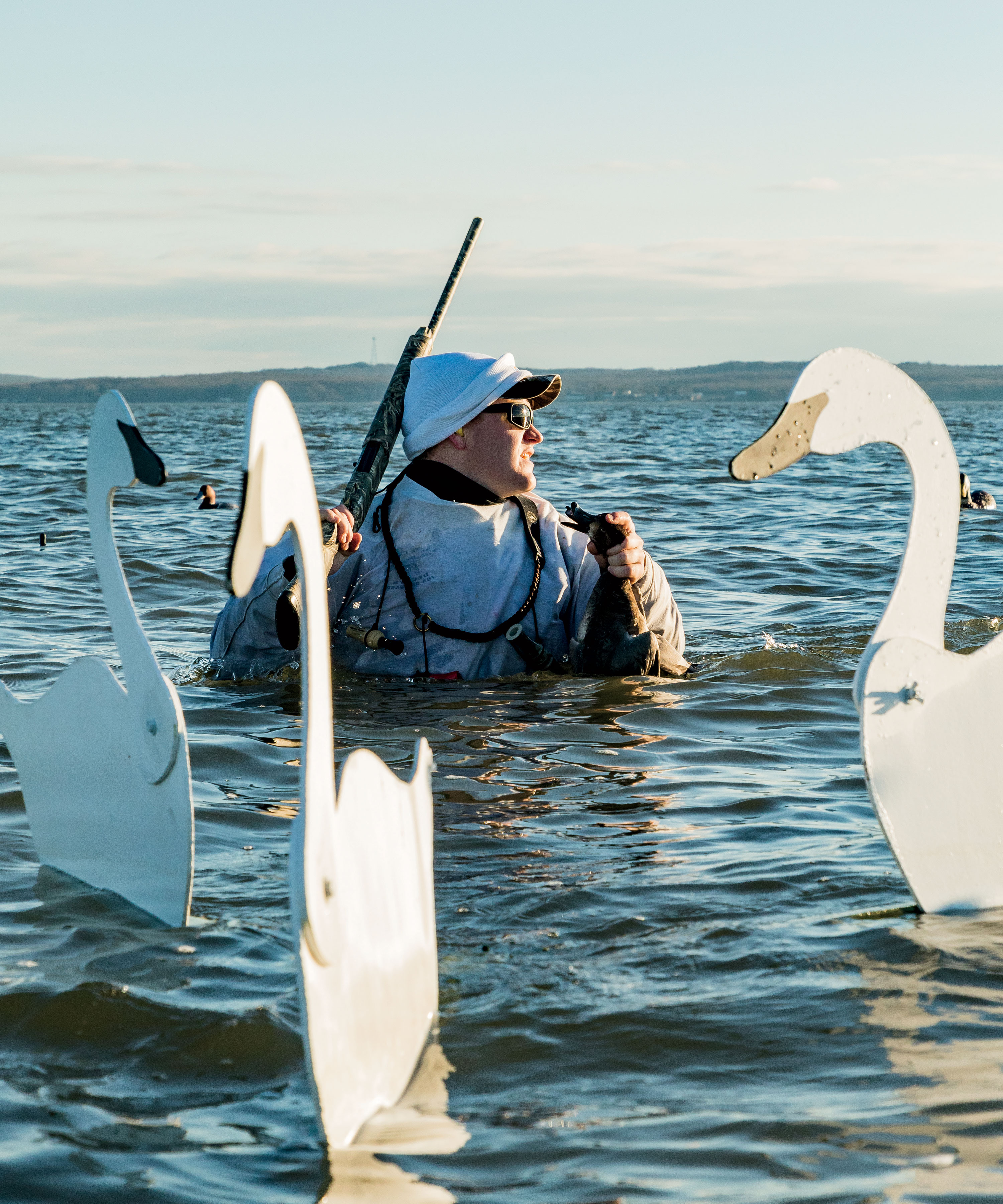
Photo: PETER FRANK EDWARDS
Jobes’s son Andrew in the decoy spread.
It’s unbelievable how many times you pick up a decoy before it’s even a decoy,” Charles says later that afternoon, standing at his shop’s workbench, the air scented with wood shavings, Ronan Superfine paint, solvent, and drying neoprene from the wet survival suits hanging near a heat-er. Regardless of species, the process is similar, and little different from when he stood on his tiptoes to reach his father’s workbench. “Cut the block of wood, put it on a lathe, turn the body, spokeshave it to shape, cut the breast and tail, sand the body smooth, and that’s all you got. The body. You haven’t even started on the head yet. Or the painting.”
The remains of that process skim-coat every surface in his shop, like dust in an attic that no one has visited in decades. Except Charles is here, working, nearly every day of his life. It’s a blend of the old and new. Hundreds of hand tools hang from racks, oyster jars cling to the ceiling like bats, filled with nails and tacks, the lids screwed to bare Sheetrock. Laundry baskets of finished heads are pushed against a wall. Dozens of silhouette forms hang above a band saw, many taken straight from Madison Mitchell’s original forms. Charles pulls out a Garcia y Vega cigar box. Inside are the patterns for the miniatures and half-size decoys he and Bobby made for years, skittish at first about producing full-size decoys in competition with their father. “Some of these patterns are more than fifty years old,” Charles says. “If someone offered me fifty thousand dollars for this box, I wouldn’t take it.” The walls are marked with hundreds of earlier orders, going back decades, scrawled in pencil up, down, and at every imaginable angle. Tacked and stuck everywhere is the Charles Jobes version of an Excel spreadsheet: hand-printed notes for orders to fill.
Event 10/4—1 gadwall, 1 BB
Small goose—ship today
5 pr RN, 2 pr PT, 2 pr CB, 5 pr GH
Oliver Diamonte, sleeper CB
According to Kneisley, the museum director, this very act of watching a decoy carver work the wood reflects how the art has survived from generation to generation. “The Jobes brothers are the quintessential example of how decoy carving was handed down from family member to family member, or through apprenticeship, from the earliest days,” she says. And there’s an emphasis on the quintessential example: Fewer than a handful of full-time carvers remain in Havre de Grace. The Jobes brothers make up nearly half the lot.
I watch as Charles carves a decoy head, reading glasses perched on his nose. He uses a drawknife to give it shape and “backlash the bill,” removing wood to let the profile of a mallard head emerge from the block. He’s had the same drawknife for twenty-one years, since his first day opening the shop. He removes the shaped head from the vise, carves out the throat, and then whittles in what he calls the “gills”—two deep scimitars to delineate the bill from the head.
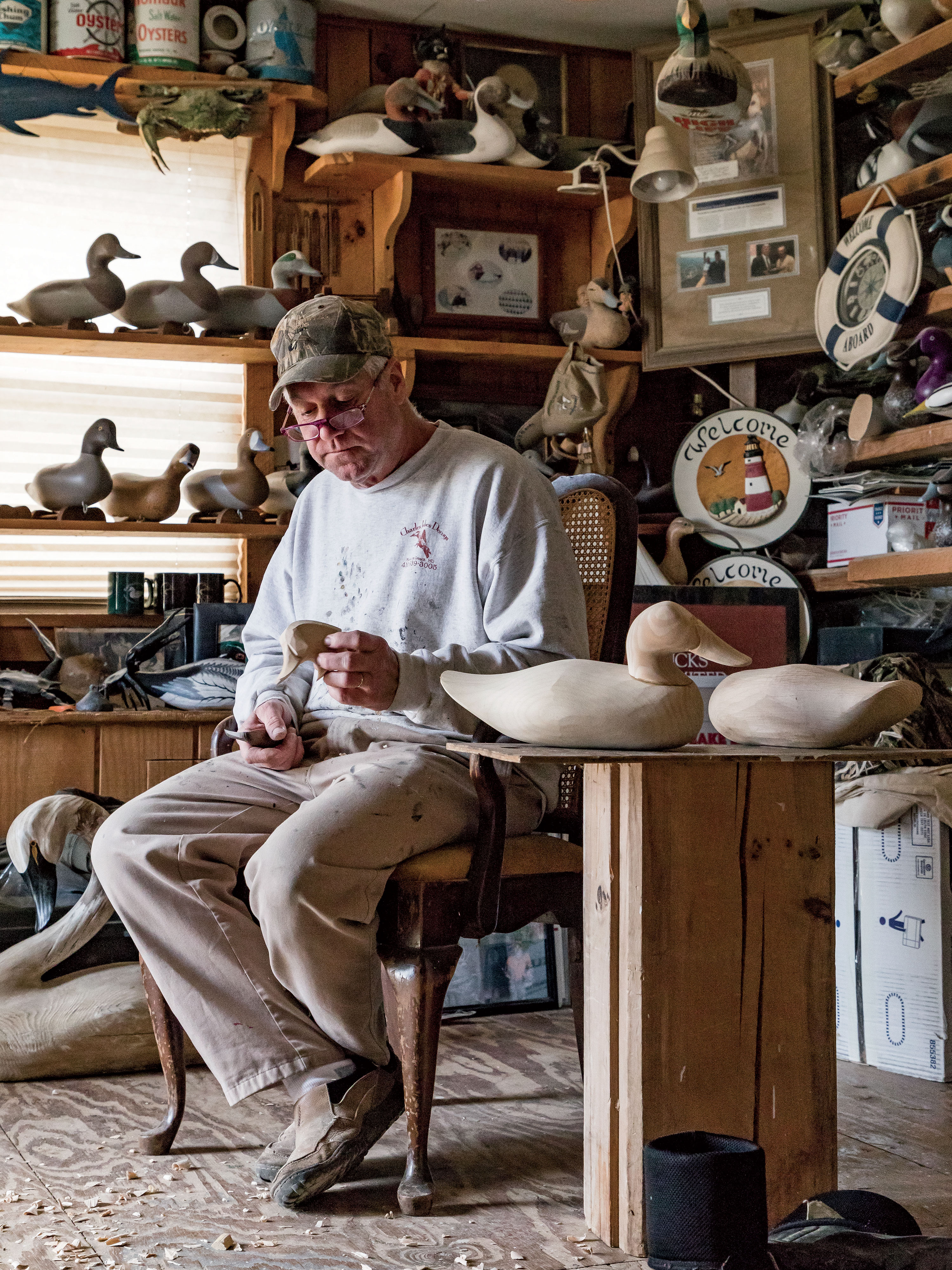
Photo: PETER FRANK EDWARDS
Charles Jobes in his workshop in Havre de Grace, Maryland.
There seems to be no end to the work. It’s just the two of them, he says, him and Patty. She’s a cheerful bundle of curly hair and big smiles who boxes up every Charles Jobes decoy and frets over every invoice. “Sometimes I’ll ask Patty: How many decoys do you think we’ve made in our lives?” he says. “We just laugh. We’d probably start crying if we knew the answer.”
I ask him: With a hunk of wood in your hand, do you feel the weight of history? Do you sense your father looking over your shoulder, the shadow of Madison Mitchell?
He hesitates. He knows where I’m trying to take this conversation. Charles sits back in the chair and palms the decoy head like an oyster.
“I like the old history and past times as much as anybody,” he says, working his way into a blunt and honest answer. “But you got to understand that I’m trying to make a living. You might not want to hear this, but I sit back and think: Can I make the next one a little faster?”
Carving a decoy is one thing. Figuring out how to make a living with a knife, a lathe, a paintbrush, and endless blocks of wood is another. Back in its heyday, in the 1990s and early 2000s, the Havre de Grace Decoy Festival took up the entire middle school plus the high school gym and the museum itself. “It was like the Fourth of July,” Charles recalls. “So many people you couldn’t even move in town, and they all lost their minds over decoys. Get a log off the shore, put a duck head on it, and paint the thing and you could sell it for thirty or forty dollars.”
In those days, decoys from the most coveted carvers brought in tens of thousands of dollars. The highest prices were stupendous. In 1986, a collector paid $319,000 for a pintail drake carved by the famed A. Elmer Crowell of Massachusetts. In 2000, a private Texas decoy collection sold for almost $11 million.
Those were historic decoys carved by widely accepted masters—Crowell has been called the Cézanne of waterfowl carving—and artistic, authentic carvers like the Jobeses benefited from the rising tide of enthusiasm for handmade decoys. Charles had decades of history with a drawknife in hand, and a direct line to the Madison Mitchell mystique. His antique-style ducks started at forty-five dollars. Geese were seventy-five. Like his father, he traveled extensively, selling decoys up and down the East Coast. “Back then,” he says, “people at the decoy shows bought multiple decoys. They’d buy birthday presents for all their kids and grandkids. It wasn’t nothing for someone to spend fifteen hundred dollars on decoys, and these were regular folks, not rich people.”
It seemed like the market for decoys couldn’t find a ceiling. In 2007, a collector paid a rumored $1.13 million each for an Elmer Crowell pintail and a Canada goose. Then, just a year later, the Dow Jones Industrial Average fell 777.68 points in a single day and dragged the decoy market underwater with it. Over two years, annual decoy sales at the prestigious Guyette & Schmidt auction house in Maryland fell from $14 million to $6 million.
The stock market crash “tore us up,” Charles says. “People didn’t need a piece of wood sitting on a shelf. They needed gasoline and food for their kids. It was rough for a long time. There were days when I would just hope somebody would order a dozen ducks so I’d have a couple hundred bucks on the way.” He turned to crabbing on the side, always a stopgap when dollars were tight. But he never stopped carving. As the economy has rebounded, collectors still make their way to the big shows in Easton and Havre de Grace, Charles says, but they don’t buy a dozen decoys. They’ll buy a pair, or perhaps an unusual drake or an uncommon species, and they buy only once or twice a year. The Rappahannock River Waterfowl Show in White Stone, Virginia, used to bring in a quarter of his yearly income. These days, in a good year, it might account for 3 percent.
What has been a game changer, however, is the conservation market for Charles’s decoys. For years he had donated birds to Ducks Unlimited chapters and fund-raisers for other groups, from the Rocky Mountain Elk Foundation to the Theodore Roosevelt Conservation Partnership. Then, in June 2008, Ducks Unlimited held its national convention in Baltimore, and Charles got a call that a few convention-goers wanted to drop by. At the time, he says, he was stressed out over a couple of small upcoming shows and was less than enthusiastic.
The next week, Ducks Unlimited’s then president, its executive secretary, a past president, and one of the organization’s largest donors spent four hours at his shop. For a long time, Charles had no idea who they were. “At one point,” he recalls, “I asked this one guy what he did for Ducks Unlimited. He said, ‘Well, I’m the national president.’ I remember saying to myself, ‘Charles, you are an idiot.’”
The next day, Charles and Patty found themselves at the organization’s President’s Luncheon in Baltimore. For the national convention the next year, they traveled to Denver to demonstrate traditional Chesapeake Bay carving and painting. “Those people appreciated a hand-carved wooden decoy,” Charles says. “They appreciated the fact that we were still right here in Havre de Grace, making decoys like folks always have.”
Orders poured in for ducks, geese, and swans. Ten years later, much of his work still winds up at Ducks Unlimited fund-raising events across the country.
He shakes his head. He calls his career “an amazing, amazing journey,” but he won’t yet call it a success. After all, he’s a son of the Chesapeake, where things come hard and success is as fleeting as the next ill tide. “Let me tell you about success,” he tells me. “My son’s getting married in June, and we can help him out without borrowing the money. You don’t know what that means to me.”
Then he shifts gears, as impish as a teenager. He has another story to share about success.
“This morning it was raining,” he says, “and Patty and I were standing in the living room, waiting for it to stop. We were just talking about this and that, really just nothing. Just being me and Patty. And when it did stop, I came out to the shop. And as soon as I walked in, I hit our little buzzer there to ring her in the house. It’s what, twenty feet? So she says, ‘What is it? You just left the house!’ And I said, ‘I just wanted to tell you that I made it to work okay.’”







